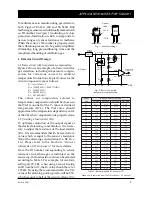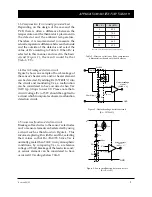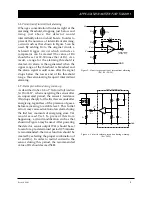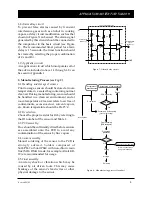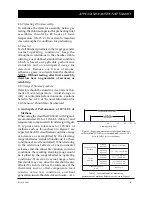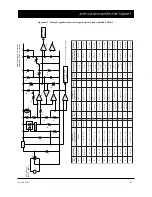
Revised
08/03
3
APPLICATION NOTES FOR TGS2611
Table 2 - Effect on selection of Rc by temperature
differential inside and outside of detector
1-3
Compensation for internally generated heat
Depending on the design of the case and the
PCB, there is often a difference between the
temperature near the thermistor’s placement in
the detector and the ambient temperature.
Therefore it is recommended to measure the
actual temperature difference between the inside
and the outside of the detector and select the
value of R
C
according to Table 2. When R
C
is
selected in this manner and used in the basic
circuit (
Figure 2
), the result would be that
Vref=1/2 Vc.
1-4
Heater breakage detection circuit
Figure 3 shows an example of how breakage of
the sensor’s heater wire and/or heater element
can be detected. By adding R
E
(3.57
Ω±
1%) into
the circuit and monitoring V
RE
, a malfunction
can be considered to have occurred when V
RE
(0.2V typ.) drops to near 0V. Please note that a
circuit voltage (Vc) of 5.2V should be applied to
a circuit which incorporates a heater malfunction
detection circuit.
1-5
Sensor malfunction detection circuit
Breakage of lead wires to the sensor’s electrodes
and/or sensor element can be detected by using
a circuit such as that shown in Figure 4. This
involves replacing R
C
with R
C1
and R
C2
, selecting
their values so that R
C1
/R
C2
≈
35. Since V
RL
is
normally greater than 70mV in any atmospheric
conditions, by comparing V
RL
to a reference
voltage of 70mV, breakage of the lead wires and/
or sensor element can be considered to have
occurred if V
RL
drops below 70mV.
Figure 3 - Heater breakage detection circuit
(R
E
= 3.57
Ω±
1%)
78M05
+
-
Vc=5.2V
R
E
GND
0.2V (typ.)
56mA (typ.)
0.05~0.1V
Heater breakage
signal
(Active = 'L')
R
A
+
-
V
REF
V
RL
R
B
R
C1
R
TH
GND
R
C2
V
C
Sensor breakage
signal
(Active = 'L')
70mV (typ.)
Figure 4 - Sensor malfunction detection circuit
(R
C1/
R
C2
≈
35)
∆∆∆∆∆
)
C
˚
(
T
k
(
c
R
Ω
)
0
5
2
.
8
5
8
6
.
7
0
1
5
1
.
7
5
1
5
6
.
6
0
2
4
3
.
6
∆
T= (temp near themistor)-(temp outside detector)


